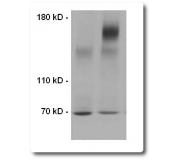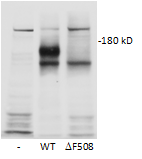Transmembrane Protein Extraction Reagent (tmPER-200; Plasma Protein Isolation)
 Click to enlarge |
|
|
Transmembrane Protein Extraction Reagent
(Plasma Membrane Protein Isolation)
Part tmper-200. 100 ml volume.
Suitable for three hundred 10 cm cell culture dishes of confluent cells. Volumes are scalable to other sized culture dishes based on the surface area of the dish.
Transmembrane Protein Extraction
The FIVEphoton Biochemicals Transmembrane Protein Extraction Reagent (tmPER-200TM) is a cell lysis-protein extraction buffer with proprietary ingredients that assist in the extraction and isolation of high molecular weight multiple-membrane spanning proteins that are otherwise poorly resolvable in standard cell lysis buffers due to aggregation tendency, lipid raft association or other insolubility issues. The Transmembrane Protein Extraction Reagent is designed to extract proteins with 4 or more transmembrane domains, yet will also effectively resolve less complex transmembrane proteins. Examples for the applicability of the FIVEphoton Biochemicals Transmembrane Protein Extraction Reagent are for enhanced resolution of ABC transporters, Ion Channels, Ion Exchangers and GPCRs in the downstream application of Western blotting. The Transmembrane Protein Extraction Reagent is applicable when RIPA buffer fails to extract and solubilize due to high molecular weight and aggregation tendency.
Transmembrane Protein Extraction Reagent: General Protocol
The researcher first employs techniques described in the protocol manual to limit endocytosis and lysosomal targeting that can otherwise result in proteolytic cleavage of cytoplasmic domains of multi-membrane spanning proteins. In the second step, the Transmembrane Protein Extraction Reagent, with added protease inhibitors, is added to dislodge cells from the cell culture dish and to dissolve the cell membrane. Following membrane dissolution, brief centrifugation is used to remove cellular debris from a supernatant fraction that contains extracted transmembrane proteins. The supernatant is added to Laemmli Sample Buffer, which is heated, but not boiled, prior to the resolution in SDS-PAGE gels. For Western blots, transfer takes place in a transfer buffer that has added SDS and reduced amounts of methanol. The transfer is allowed to proceed approximately 25% longer than typically used in Western blotting protocols.
Figure legend. Wild type (WT) and deltaF508 CFTR, a 12 TM domain protein, expressed by adenovirus infection in MDCK cells and extracted with the Transmembrane Protein Extraction Reagent. WT CFTR reveals an upper 170 kD band that reflects complex glycosylation, as well as a core-glycosylated band. In contrast, deltaF508 CFTR is trafficking impaired, remains in the endoplasmic reticulum and therefore is only synthesized with a core glycosylated band. The trafficking impairment is the underlying cause of cystic fibrosis.
Icon Image: CFTR expressed stably in HEK293 cells and extracted with the Transmembrane Protein Extraction Reagent. Western blot of the wild-type variant capturing both core and complex glycosylation.
Supplemental Products
|
|
- Gardner CC, James PF. (2023). The SLC9C2 Gene Product (Na+/H+ Exchanger Isoform 11; NHE11) Is a Testis-Specific Protein Localized to the Head of Mature Mammalian Sperm. International Journal of Molecular Sciences. 2023; 24(6):5329. https://doi.org/10.3390/ijms24065329
- K J Senthil Kumar, M Gokila Vani, Hen-Wen Hsieh, Chin-Chung Lin, Jiunn-Wang Liao, Pin-Ju Chueh, Sheng-Yang Wang (2019) MicroRNA-708 activation by glucocorticoid receptor agonists regulate breast cancer tumorigenesis and metastasis via downregulation of NF-κB signaling, Carcinogenesis, , bgz011, Link to article
- Robinson, E et. al. (2018). Lipid Nanoparticle-Delivered Chemically Modified mRNA Restores Chloride Secretion in Cystic Fibrosis. Molecular Therapy. Volume 26, Issue 8, 1 August 2018, Pages 2034-2046. Link to article
-
Downey, Anne Marie, Barbara F. Hales, and Bernard Robaire. "Zinc Transport Differs in Rat Spermatogenic Cells and Is Affected by Treatment with Cyclophosphamide." Biology of Reproduction(2016): biolreprod-116. Link to article
- Kang, X., Lu, Z., Cui, C., Deng, M., Fan, Y., Dong, B., ... & Zhang, C. C. (2015). The ITIM-containing receptor LAIR1 is essential for acute myeloid leukaemia development. Nature cell biology. Link to article.
- Dae-Gyun Ahn, Tanveer Sharif, Kenneth Chisholm, Devanand M Pinto, Shashi A Gujar & Patrick WK Lee (2015) Ras transformation results in cleavage of reticulon protein Nogo-B that is associated with impairment of IFN response, Cell Cycle, 14:14, 2301-2310. Link to article
Tissues
Li, M. H., Suchland, K. L., & Ingram, S. L. (2016). Compensatory activation of cannabinoid CB2 receptor inhibition of GABA release in the rostral ventromedial medulla (RVM) in inflammatory pain. Journal of Neuroscience, 1310-16. Link to article.
Plant Cells
- Gerttula, S., Zinkgraf, M., Muday, G., Lewis, D., Ibatullin, F. M., Brumer, H., ... & Groover, A. (2015). Transcriptional and Hormonal Regulation of Gravitropism of Woody Stems in Populus. The Plant Cell, tpc-15. Link to article
- Wang, Y., Itaya, A., Zhong, X., Wu, Y., Zhang, J., van der Knaap, E., ... & Ding, B. (2011). Function and evolution of a microRNA that regulates a Ca2+-ATPase and triggers the formation of phased small interfering RNAs in tomato reproductive growth. The Plant Cell, 23(9), 3185-3203. Link to article
Protocol
Representative References of High Molecular Weight Transmembrane Proteins
1. Berberian G, Bollo M, Montich G, Roberts G, Degiorgis JA, et al. 2009. A novel lipid binding protein is a factor required for MgATP stimulation of the squid nerve Na+/Ca2+ exchanger. Biochim Biophys Acta 1788: 1255-62
2. Castro-Parodi M, Levi L, Dietrich V, Zotta E, Damiano AE. 2009. CFTR may modulate AQP9 functionality in preeclamptic placentas. Placenta 30: 642-8
3. Chen WY, Xu WM, Chen ZH, Ni Y, Yuan YY, et al. 2009. Cl- is required for HCO3- entry necessary for sperm capacitation in guinea pig: involvement of a Cl-/HCO3- exchanger (SLC26A3) and CFTR. Biol Reprod 80: 115-23
4. Gad A, Callender DL, Killeen E, Hudak J, Dlugosz MA, et al. 2009. Transient in utero disruption of cystic fibrosis transmembrane conductance regulator causes phenotypic changes in alveolar type II cells in adult rats. BMC Cell Biol 10: 24
5. Ghoshal A, Mukhopadhyay S, Demine R, Forgber M, Jarmalavicius S, et al. 2009. Detection and characterization of a sialoglycosylated bacterial ABC-type phosphate transporter protein from patients with visceral leishmaniasis. Glycoconj J 26: 675-89
6. Glaser SS, Gaudio E, Rao A, Pierce LM, Onori P, et al. 2009. Morphological and functional heterogeneity of the mouse intrahepatic biliary epithelium. Lab Invest 89: 456-69
7. Huang D, Gao Q, Guo L, Zhang C, Jiang W, et al. 2009. Isolation and identification of cancer stem-like cells in esophageal carcinoma cell lines. Stem Cells Dev 18: 465-73
8. Kang KW, Im YB, Go WJ, Han HK. 2009. C-myc amplification altered the gene expression of ABC- and SLC-transporters in human breast epithelial cells. Mol Pharm 6: 627-33
 Products
Products Manuals
Manuals







 - FIVEphoton Biochemicals-80x80.jpg)





